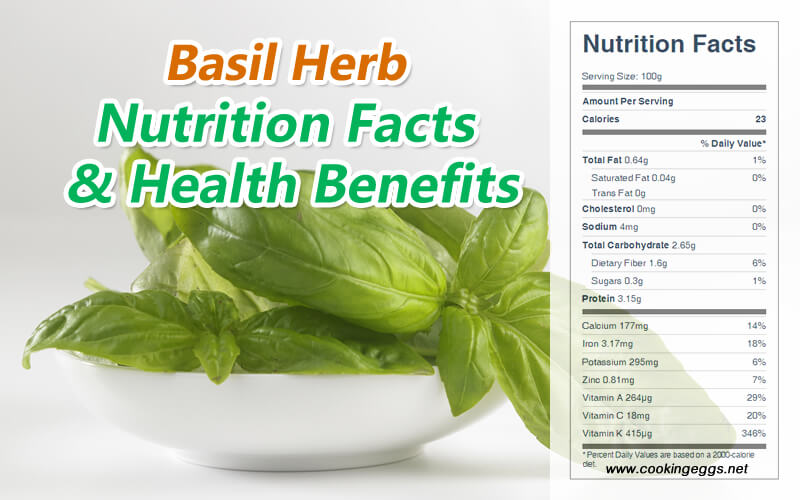Basil Nutrition Facts and Health Benefits
Basil (Ocimum basilicum), also known as sweet basil, is a culinary herb of the mint family. Basil is native to India, where its medicinal and aromatic uses have been known for several millennia, and now grows wild in tropical and sub-tropical regions, including America and Central Africa.
There are many types of basil, including sweet basil, Thai basil, lemon basil, and African blue basil, each slightly different in aroma and taste. One of the most widely used herbs for seasoning tomatoes and tomato sauces, basil plays a key role in Mediterranean, Asian, and Middle Eastern cuisine. Basil particularly complements the flavors of garlic and olives. It is also pleasing when combined with lemon. Basil is both tonic and calming to the nervous system, making it a natural tranquilizer for the kind of frazzled nerves that lead to insomnia.
Nutritional Value of Fresh Basil
Fresh basil is 92% water, 2.6% carbohydrates, 3% protein, and contains negligible fat. In a 100-gram reference amount, fresh basil supplies 23 calories, 2.65 g carbohydrate, 3.15 g protein, 0.64 g fat, 5280 IU vitamin A, 18 mg vitamin C, 415 μg vitamin K, 177 mg calcium, 3.17 mg iron, 64 mg magnesium, 1.15 mg manganese, 295 mg potassium, 0.81 mg zinc, and 0.38 mg copper.

Fresh Basil Nutrition Facts Label
Health Benefits of Basil
Basil is an important source of eugenol, which is an antibacterial agent and nematicide, demonstrating efficacy against food-borne pathogens. Its anti-bacterial properties may help prevent or treat gastro-enteritis. In traditional medicine, it is used as an analgesic and to eliminate worms from the intestines.
Basil contains more than 5280 IU of vitamin A, including 3140 mcg of beta-carotene. There are 5650 mcg of lutein and zeaxanthin, which are superstars of eye nutrition and offer protection against age-related macular disease, especially in older adults.
Basil is rich in vitamin A (29% of the DV). It is important for the immune system because it is needed for the differentiation of cells into the various types of immune cells. Vitamin A is an essential nutrient required for maintaining healthy mucosa and skin and is essential for good night vision. Vitamin A and flavonoids may offer protection against lung and oral cavity cancers.
Basil contains many polyphenolic flavonoids, vitamin C, and beta-carotene. Some unconverted carotenoids also reach the blood and tissues, where they may function as antioxidants. Rosmarinic acid isolated from the leaves of basil has antioxidant activity. The ethanolic extract of the leaves of Basil showed significant antilipid peroxidation effects in vitro.
Basil is a rich source of vitamin K. A 100 g serving of this herb supplies 415 μg of this essential vitamin, which is equivalent to almost 346% of the daily recommended intake. Vitamin K functions as a coenzyme for biological reactions involved in blood coagulation and bone metabolism. It may have a role in osteoporosis and vascular health.
Basil is a good source of iron. Fresh basil leaves contain 3.17 mg/100 g (about 18% of the DV) of iron. Iron is essential for red blood cells, where most of the human body's iron is contained. It is one of the chief determinants of the oxygen-carrying capacity of the blood.
In addition, basil leaves contain a good amount of essential minerals like calcium(18% of the DV), potassium(6% of the DV), manganese(55% of the DV), copper(19% of the DV), and magnesium(18% of the DV). Calcium is well known for its function in maintaining bone and tooth health, but it is also critical to cell signaling, blood clotting, muscle contraction, and nerve function. Potassium is an important component of cell and body fluids, which helps control heart rate and blood pressure. Magnesium is an essential mineral that is critical for many metabolic functions in the body. Manganese is utilized by the human body as a co-factor for the antioxidant enzyme, superoxide dismutase.
Uses of Basil in Traditional Medicine
The leaves and infusions of basil are widely used in traditional medicine. In some Mediterranean areas, such as Eastern Morocco, they are used to decrease plasma lipid content, while the Santhal tribe of India uses sweet basil for headaches, earaches, coughs, colds, infections, snake bites, and rabies. Basil leaves have also been used to treat diarrhoea, dysentery, constipation, flatulence, and worms; as an analgesic and insect repellent; to relieve symptoms of bronchitis, flu, colds, coughs, and sinusitis; and to treat rheumatism, muscle aches, gout, and exhaustion.The leaves are also reported to be effective in the treatment of warts; an ointment made of basil leaves can be used as a treatment for insect bites and can be applied directly to the skin as a cure for acne.
The juice expressed from the leaves also has a number of therapeutic uses; it relieves the symptoms of colds and coughs, and those of croup when mixed with honey. It is also used as a treatment for toothaches, earaches, and headaches and can be mixed with camphor to stop nasal hemorrhage. It is said to give lustre to the eyes, and forms an excellent nostrum for the cure of ring worms, scorpion stings, and snake bites.
Basil seeds steeped in water and eaten are said to be cooling and very nourishing. The seeds are chewed as a treatment for snake bites. The washed and pounded seeds are used in poultices for unhealthy sores and sinuses and are also used in sharbat for the treatment of chronic constipation and in internal piles. A teaspoon of seed in a tumbler of water with a little sugar, taken daily, acts as a demulcent in genito-urinary disease; a cold infusion of seeds is said to relieve childbirth afterpains; and an infusion of seeds is also given in fever. The aqueous extract of the seeds is used as a diuretic. Finally, the roots of the plant are used for bowel complaints in children.